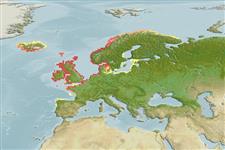Common names from other countries
Classification / Names / Names
Common names | Synonyms | Catalog of Fishes (gen., sp.) | ITIS | CoL | WoRMS
Environment: milieu / climate zone / depth range / distribution range
Ecology
Demersal; brackish; depth range 7 - 9 m (Ref. 2851). Subtropical; 72°N - 26°N, 20°W - 30°E
Eastern Atlantic: From Norway. Germany and Portugal to Morocco and Canary Islands.
Length at first maturity / Size / Weight / Age
Maturity: Lm ? range ? - ? cm
Depth based on occurrence (Ref. 2851, p. 719); to be replaced with better reference. Omnivore, feeding based on genus (Ref. 96430).
Life cycle and mating behavior
Maturity | Reproduction | Spawning | Eggs | Fecundity | Larvae
Members of the order Mysida are gonochoric. Mating behavior: Male inserts the penis into the marsupium and releases sperm; eggs are then released from the oviducts into the marsupium where fertilization occurs. Life cycle: Eggs are brooded in the marsupium and later hatch into miniature adults, no postlarva.
Alves, F., L. Chicharo, A. Nogueira and J. Regala. 2003. (Ref. 2851)
IUCN Red List Status (Ref. 130435)
CITES status (Ref. 108899)
Not Evaluated
Not Evaluated
Human uses
| FishSource |
Tools
More information
Age/Size
Growth
Length-weight
Length-length
Morphology
Larvae
Abundance
Internet sources
Estimates based on models
Preferred temperature
(Ref.
115969): 8.9 - 12.8, mean 10.6 (based on 366 cells).
Price category
Unknown.
